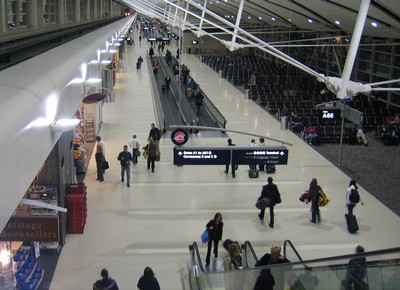Traveling With Your Hearing Aids
Tuesday, June 26th 2012
Thanks to advances in technology, most of us can take the comforts of home with us wherever we travel. If you're one of the four million Americans who use hearing aids, a little advanced planning can go a long way in ensuring your devices will perform as well for you on vacation as they do every other day.
1. Airline travel. If you're traveling by air, it's important to know that your hearing devices won't be damaged by any of the scanning devices used by the Transportation Security Administration. That means you don't need to remove your hearing aids to go through the security screening process at the airport.

In fact, the TSA prefers that you wear your hearing aids during this process just in case TSA officials need to communicate with you. You may want to turn the volume down, as some scanners can cause excessive noise in your hearing aids. Remember that alternate methods of screening, such as pat downs, are available upon request if you're concerned about the safety of body scanners.
The TSA also recently launched a special hotline, TSA Cares, to assist passengers with disabilities or medical needs regarding their questions. This call line is designed to help passengers before reaching the airport, and can be reached by dialing 1-855-787-2227. Operators will be able to answer questions regarding security and boarding procedures, in addition to other passenger concerns.
Also, most hearing assisting devices are approved for in-flight use which means you don't have to turn them off when the flight attendant asks passengers to power off their personal electronic devices (PED). The exception is a FM system, which falls under the same classification as a cell phone and must be switched off along with other PEDs.
2. By Train. When you travel by rail, let gate attendants know you have a hearing loss so they can make you aware of any gate changes -- just in case you have trouble hearing the public address system in a busy terminal. Also, make sure to watch carefully as you're walking near the tracks. With all of the noise in a train station, it's important not to rely on hearing alone to know when a train is approaching the station.
3. By Car. If you're driving to your destination, consider purchasing an extra large rearview mirror. This will help you see approaching emergency personnel instead of relying on sound alone. If other passengers are traveling with you, look into having an induction loop installed. This electronic device will allow you to better hear and understand your radio, cell phone and conversation from other passengers.
If you're still concerned with what protocol to follow depending on your mode of travel, don't be afraid to contact the airline or motor system with remaining questions. Also, your hearing aid professional or audiologist can provide you with more tips on what to consider before traveling the open skies, rails or roads.
Fuente: Healthy Hearing
http://healthyhearing.com/content/articles/Assistance/Awareness/50332-Traveling-with-your-hearing-aids?utm_source=Healthy+Hearing+Newsletter&utm_campaign=a20d3ddf97-HH_Update_June_27_Issue_A_B&utm_medium=email
1. Airline travel. If you're traveling by air, it's important to know that your hearing devices won't be damaged by any of the scanning devices used by the Transportation Security Administration. That means you don't need to remove your hearing aids to go through the security screening process at the airport.

In fact, the TSA prefers that you wear your hearing aids during this process just in case TSA officials need to communicate with you. You may want to turn the volume down, as some scanners can cause excessive noise in your hearing aids. Remember that alternate methods of screening, such as pat downs, are available upon request if you're concerned about the safety of body scanners.
The TSA also recently launched a special hotline, TSA Cares, to assist passengers with disabilities or medical needs regarding their questions. This call line is designed to help passengers before reaching the airport, and can be reached by dialing 1-855-787-2227. Operators will be able to answer questions regarding security and boarding procedures, in addition to other passenger concerns.
Also, most hearing assisting devices are approved for in-flight use which means you don't have to turn them off when the flight attendant asks passengers to power off their personal electronic devices (PED). The exception is a FM system, which falls under the same classification as a cell phone and must be switched off along with other PEDs.
2. By Train. When you travel by rail, let gate attendants know you have a hearing loss so they can make you aware of any gate changes -- just in case you have trouble hearing the public address system in a busy terminal. Also, make sure to watch carefully as you're walking near the tracks. With all of the noise in a train station, it's important not to rely on hearing alone to know when a train is approaching the station.
3. By Car. If you're driving to your destination, consider purchasing an extra large rearview mirror. This will help you see approaching emergency personnel instead of relying on sound alone. If other passengers are traveling with you, look into having an induction loop installed. This electronic device will allow you to better hear and understand your radio, cell phone and conversation from other passengers.
If you're still concerned with what protocol to follow depending on your mode of travel, don't be afraid to contact the airline or motor system with remaining questions. Also, your hearing aid professional or audiologist can provide you with more tips on what to consider before traveling the open skies, rails or roads.
Fuente: Healthy Hearing
http://healthyhearing.com/content/articles/Assistance/Awareness/50332-Traveling-with-your-hearing-aids?utm_source=Healthy+Hearing+Newsletter&utm_campaign=a20d3ddf97-HH_Update_June_27_Issue_A_B&utm_medium=email
No hay comentarios:
Publicar un comentario